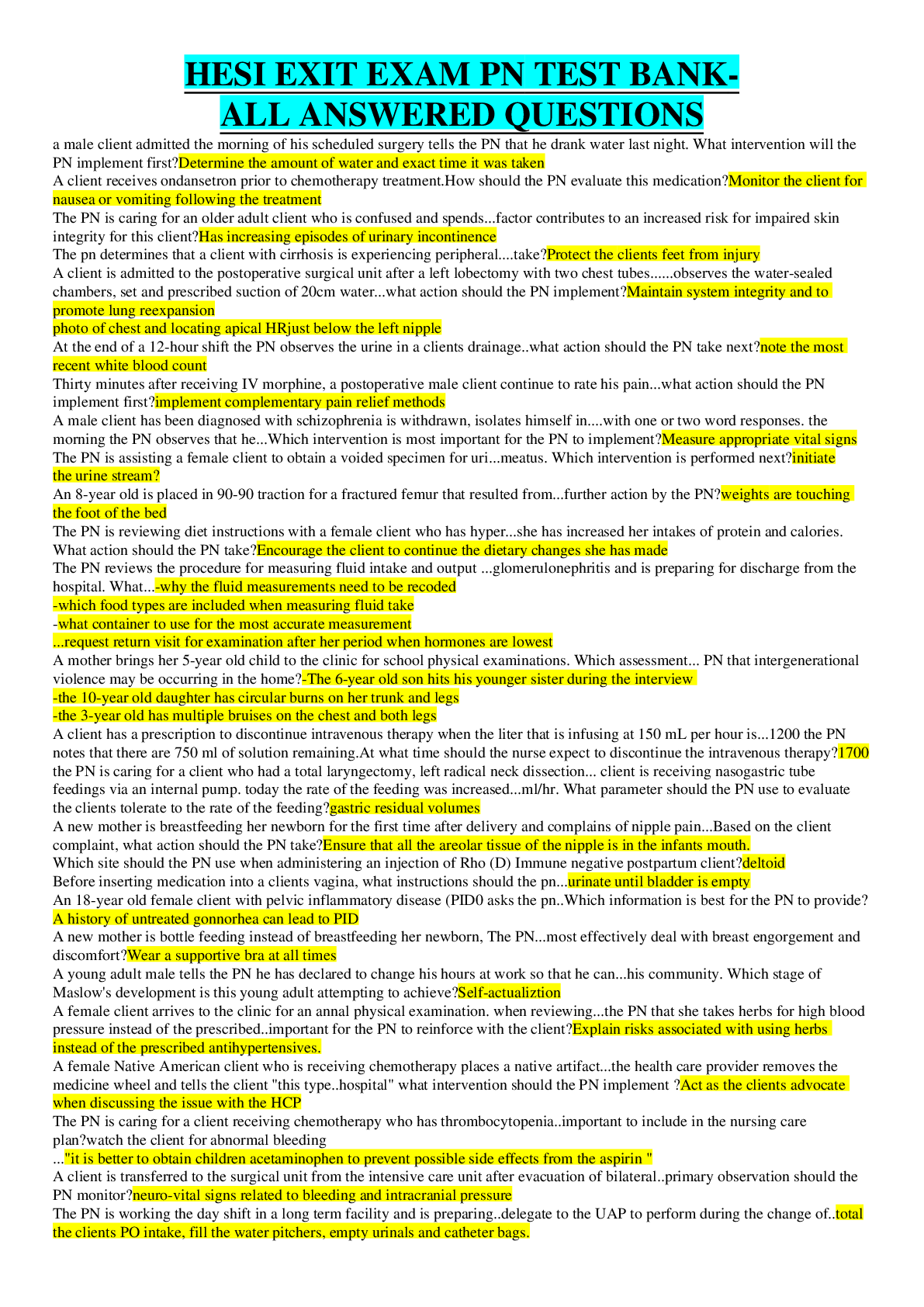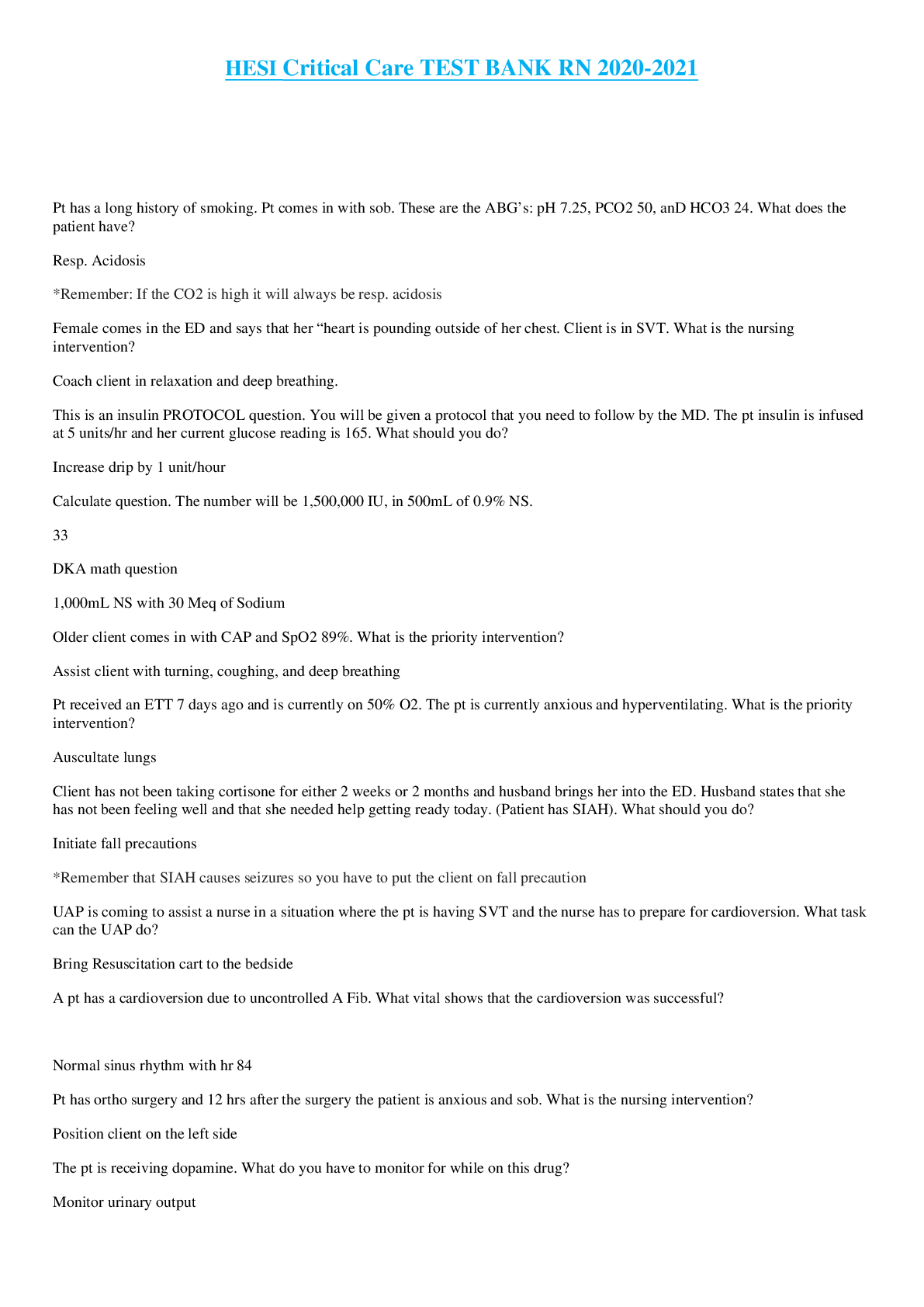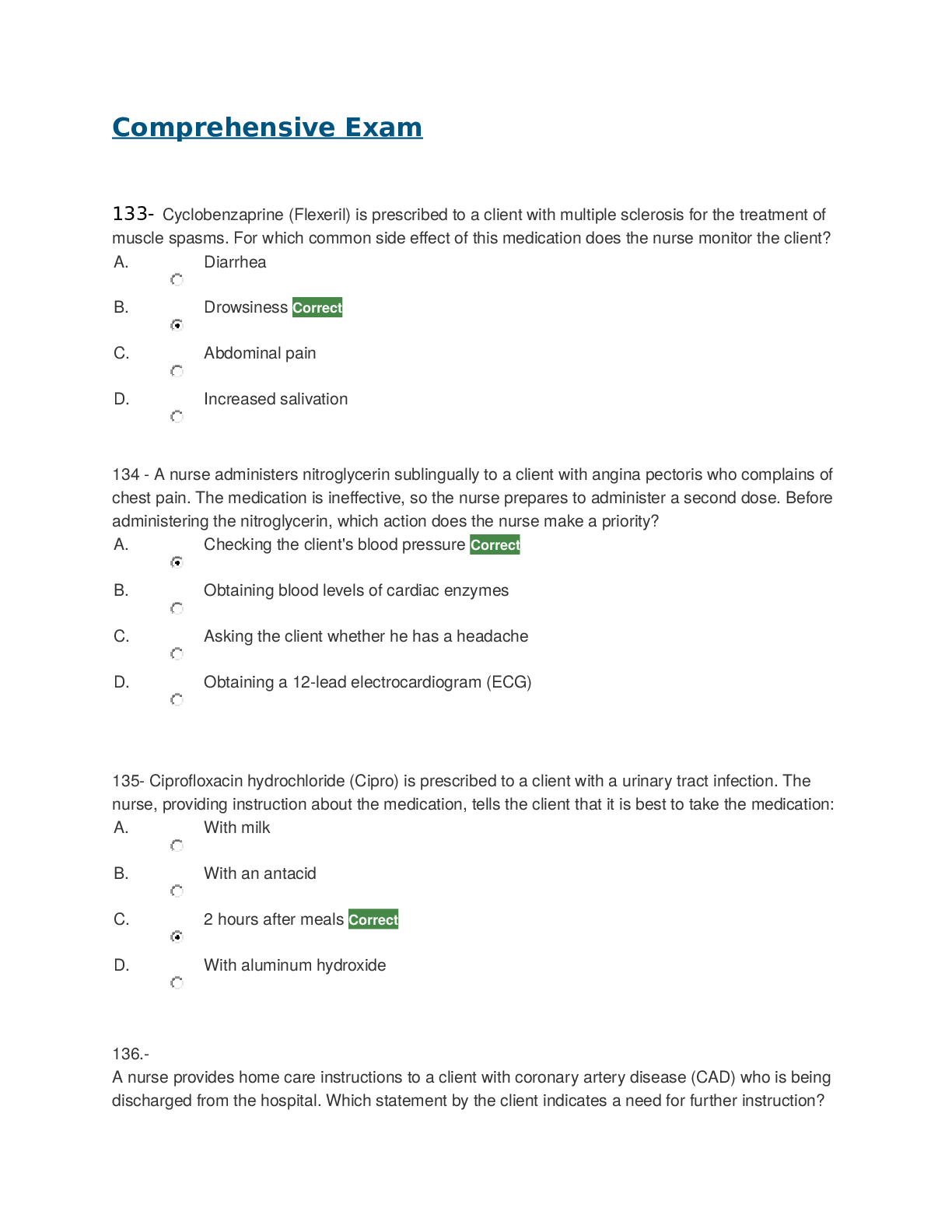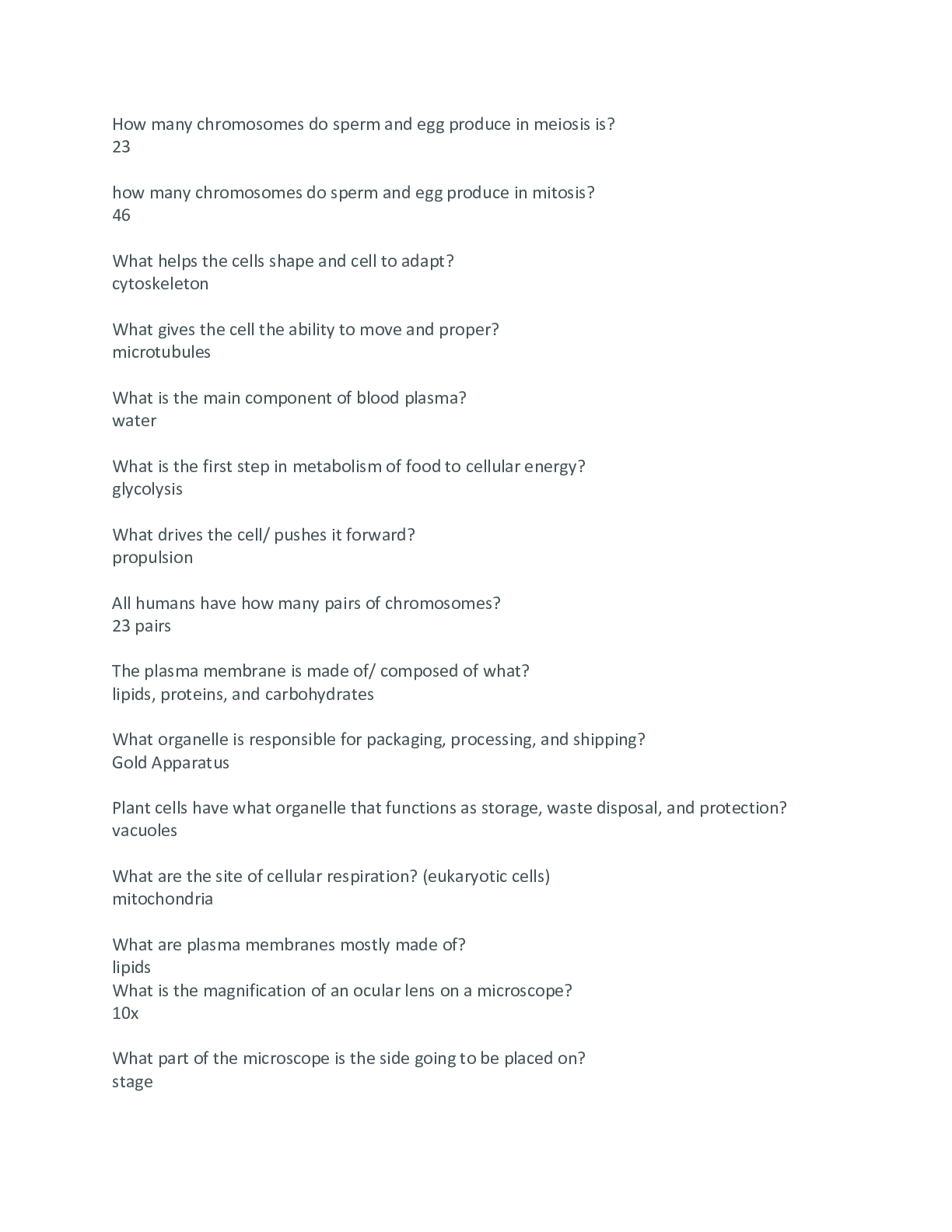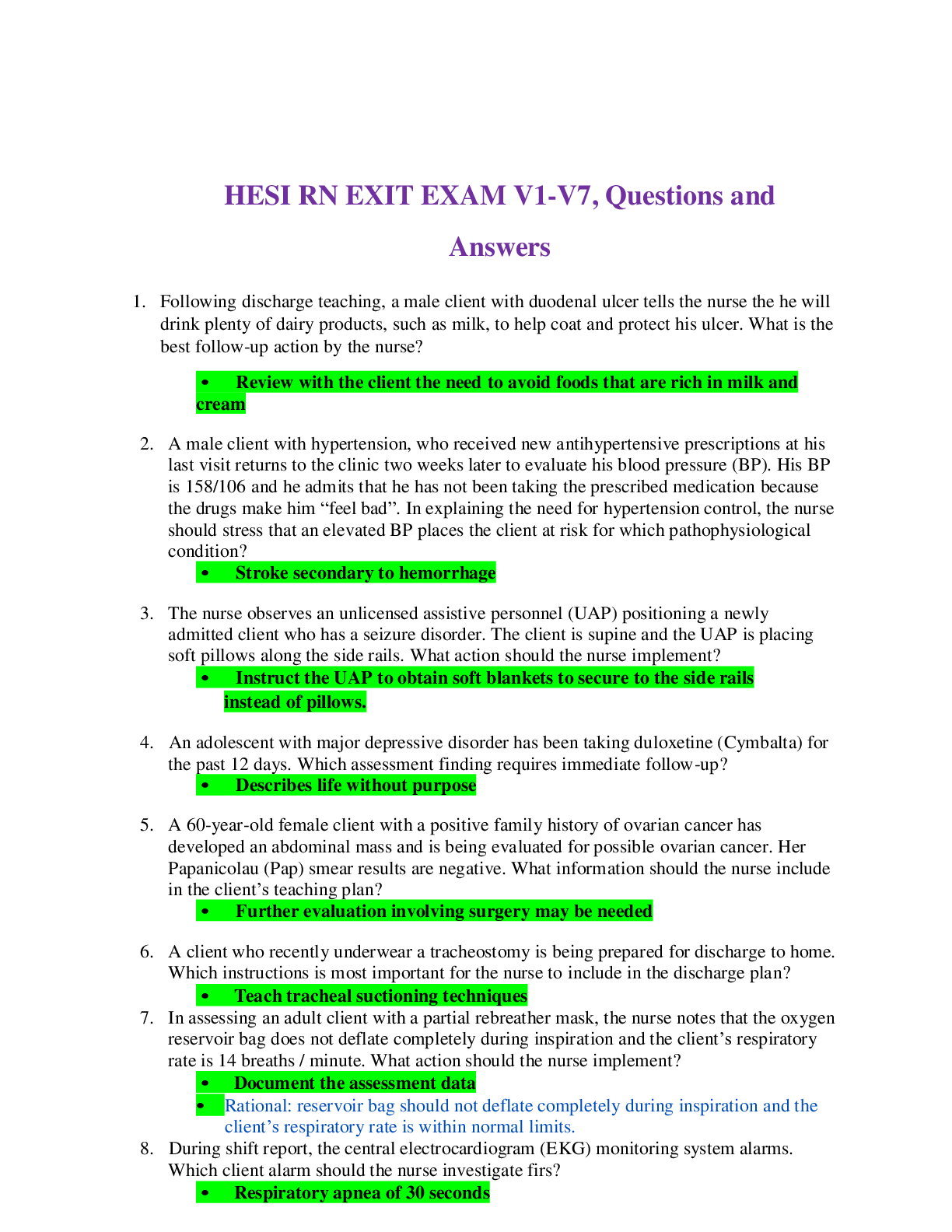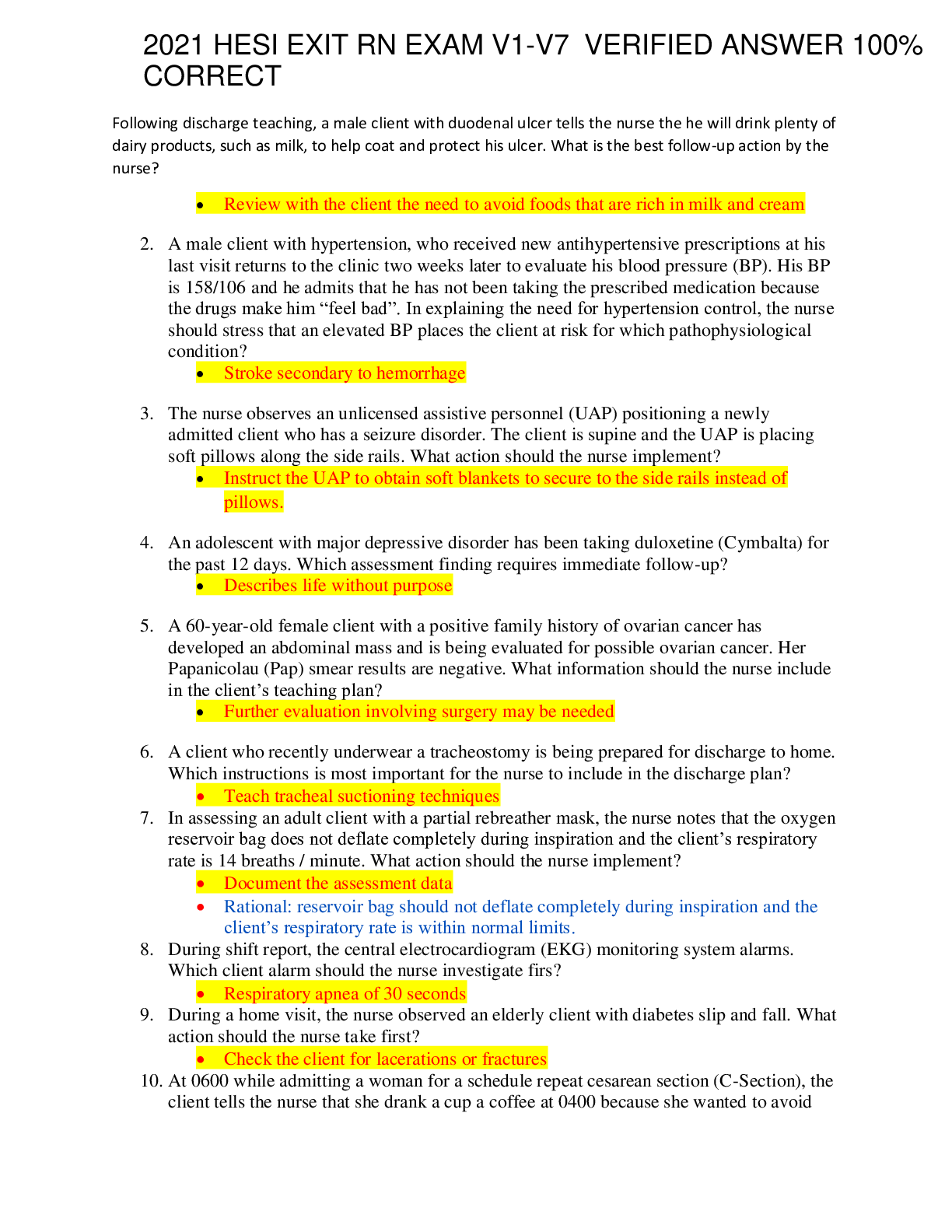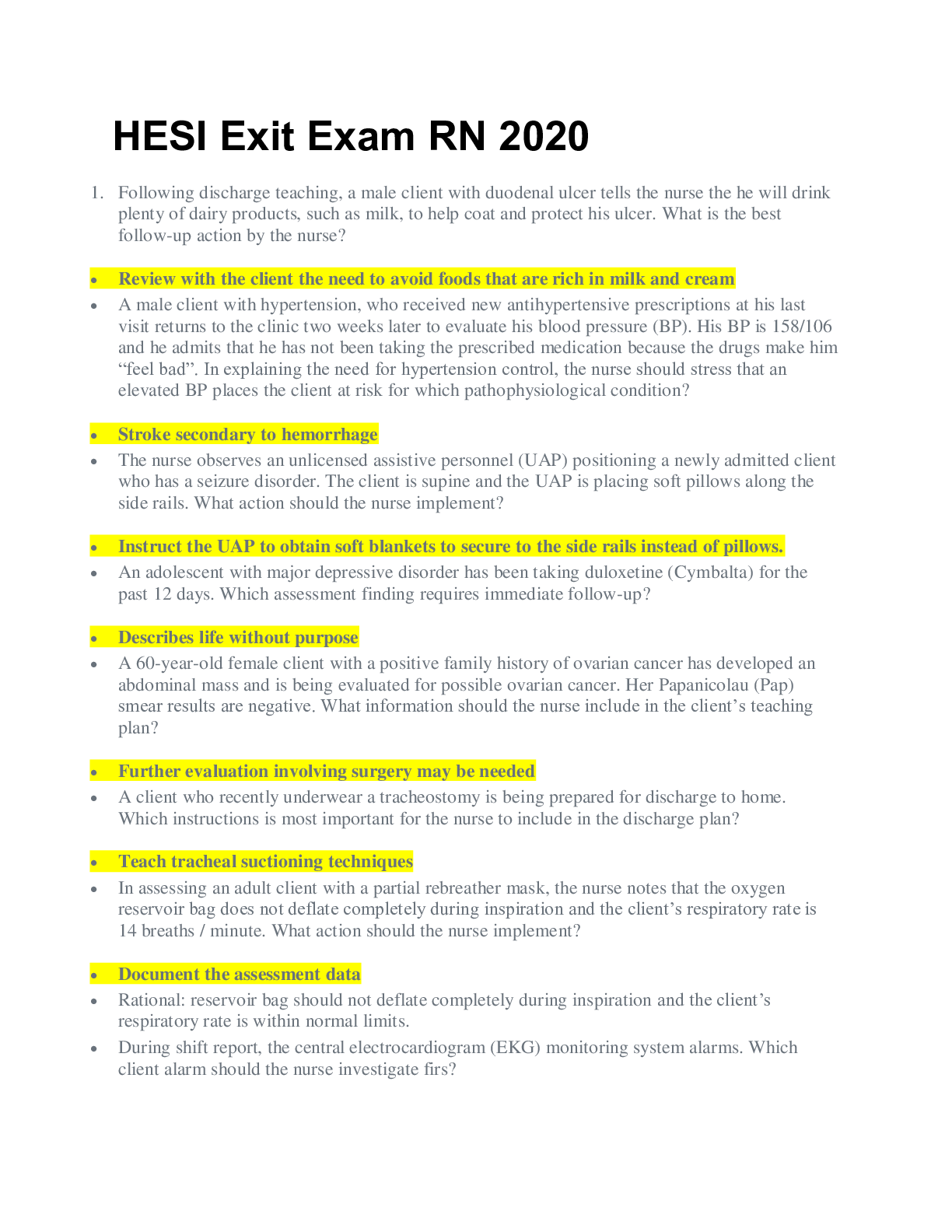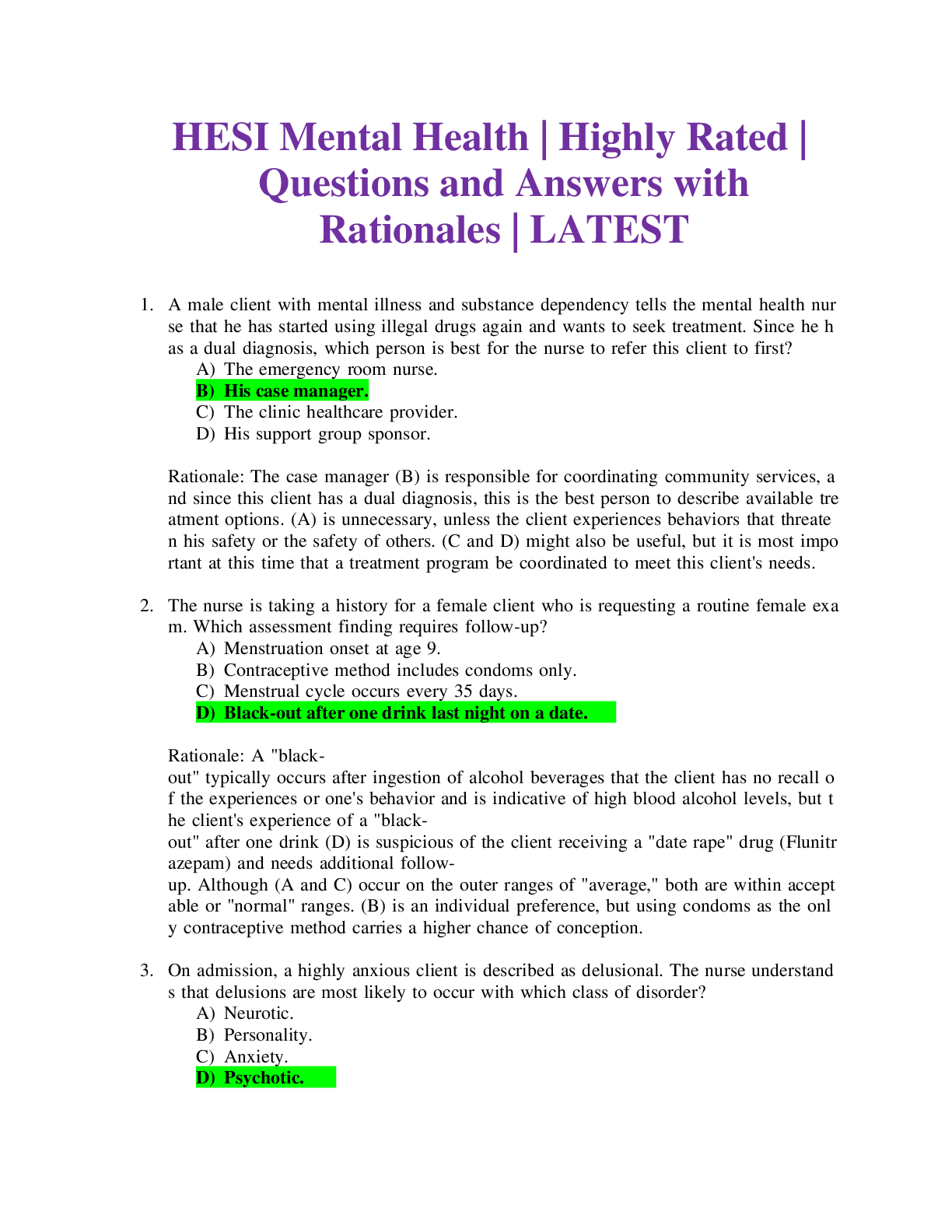HESI 2019 EXIT RN Version 3,100% CORRECT
Document Content and Description Below
. The nurse is planning to teach infant care preventive measures for sudden infant death syndrome (SIDS) to a group of new parents. Which information is most important for the nurse to include? A. En... sure the infant’s crib mattress is firm. B. Place the infant in a prone position whenever possible. C. Swaddle the infant in a blanket for sleeping. D. Prop the infant with a pillow when in a side-lying position. 2. An elderly female is admitted because of a change in her level of sensorium. During the evening shift, the client attempts to get out bed and falls, breaking her left hip. Buck’s skin traction is applied to the left leg while waiting for surgery. Which intervention is most important for the nurse to include in this client’s plan care? A. Assess the skin under the traction moleskin. B. Place a pillow under the involved lower left leg. C. Ensure proper alignment of the leg in traction. D. Evaluate her response to narcotic analgesic. 3. The camp is teaching adolescents about the prevention of tinea pedis. Which instruction should the nurse include in the teaching plan? A. Use moisturizing creams to retain skin moisture. B. Avoid using cosmetics that block sebaceous glands. C. Do not share a brush or comb with anyone. D. Wear water shoes in the public shower. 4. The nurse observes an unlicensed assistive personnel (UAP) positioning a newly admitted client who has a seizure disorder. The client is supine and the UAP is placing soft pillows along the side rails. What action should the nurse implement? A. Advice the UAP to observe the client’s skin while the heating pads are in place. B. Elevate the client’s feet on a pillow and monitor the client’s pedal pulses frequently. C. Instruct the UAP to obtain soft blankets to secure to the side rails instead of pillows. D. Remove the heating pads and place a soft blanket over the client’s leg and feet 5. The unlicensed assistive personnel (UAP) reports that a client’s blood pressurecannot be measured because the clients has cats on both arms and is unable to be turned to the prone position for blood pressure measurement in the legs. Which action should the nurse implement? A. Advise the UAP to document the last blood pressure obtained on the client’s graphic sheet. B. Demonstrate how to palpate the popliteal pulse with the client supine and the knee flexed. C. Estimate the blood pressure by assessing the pulse volume of the client’s radial pulses. D. Document why the blood pressure cannot be accurately measured at the present time. 6.The nurse is developing an educational program for older clients who are being discharged with new antihypertensive medications. The nurse should ensure that the educational materials include which characteristics? (Select all that apply) A. Written at a twelfth-grade reading level B. Contains a list with definitions of unfamiliar terms C. Uses common words with few Syllables D. Printed using a 12-point type font E. Uses pictures to help illustrate complex ideas 7. An antacid is prescribed for a client with gastroesophageal reflux (GERD). The client asks the nurse, “How does this help my GERD?” Which is the best response by the nurse? A. This medication will coat the lining of your esophagus B. Antacids will neutralize the acid in your stomach C. It will improve the emptying of food through your stomach D. antacids decrease the production of gastric secretions 8. A nurse who usually works on a step-down unit is moved to work a 12-hour shift in the critical care unit. Which client is best for the charge nurse to assign to this nurse? A. A ventilated client admitted today with respiratory failure and respiratory acidosis. B. A client who has a new onset diabetic ketoacidosis (DKA) and is on disease (COPD) C. A ventilator dependent client with chronic obstructive pulmonary disease (COPD) D. A client admitted for a narcotic overdose who is ventilated an has respiratory alkalosis. 9. An adult who has recurrent episodes of depression tells the nurse that the prescribed antidepressant needs to be discontinued because the client is feeling better after taking the medication for the past couple of weeks and does not like the side effects. Which response is the best for the nurse to provide? A. Tell the client that the medication’s side effects will most likely dissipate over time. B. Remind the client that feeling better is the therapeutic effect of the medication. C. Inform the client that gradual tapering must be used to discontinue the medication. D. Tell the client to discuss the medication side effects with the healthcare provider. 10. A. B. C. D. 11. A client who was splashed with a chemical has both eyes covered with bandages. When assisting the client with eating, which intervention should the nurse instruct the unlicensed assistive personnel (UAP) to implement? A. Feed the client the entire meal. B. Orient the client to the location of the food on the plate. C. Ask to visit during meal time to assist with feeding. D. Provide with only finger foods 12. The nurse is providing preoperative education for a Jewish client scheduled to receive a xenograft to promote burn healing. Which information should the nurse provide this client? A. Grafts are later removed by a debriding procedure. B. The xenograft is taken from nonhuman sources. C. Grafting increase the risk for bacterial infections. D. As the burn heals, the graft permanently attaches. 13. A female client presents in the Emergency Department and tells the nurse that she was raped last night. Which question is most important for the nurse to ask? A. Does she know the person who raped her? B. Has she taken a bath since the raped occurred? C. Is the place where she lived a safe place? D. Did she report the rape to the police Department? 14. A client presents to the clinic with concerns regarding her left breast. Which assessment findings most important for the nurse to report to the healthcare provider? A. A slight asymmetry of the breasts. B. Bloody discharge from the nipple. C. A fixed nodular mass with dimpling of skin. D. Multiple firm, round, freely moveable masses. 15. An older client with emphysema who continues to smoke cigarettes continues to smoke cigarettes returns to the medical unit after a physical therapy session and is short of breath. The nurse notes that the client is lying supine with the head of the bed elevated to 45 degrees. Oxygen is flowing via nasal cannula at 3L/minute. The client’s pulse oximetry is 88%, respiratory rate is 14 breaths/minute, and vital signs are stable. Which intervention should the nurse implement? A. Notify the physician of the low pulse oximetry value. B. Assess lung sounds for signs of infection. C. Administer a prescribed albuterol inhaler. D. Encourage the client to initiate a smoking cessation program. 16. The nurse is preparing a 50 ml dose of 50% Dextrose IV for a client with insulin shock. How should the nurse administer the medication? A. Ask the pharmacist to add the Dextrose to a TPN solution. B. Mix the dextrose in a 50 ml piggyback for a total volume of 100 ml. C. Push undiluted slowly though the currently infusing IV. D. Dilute the dextrose in one liter of 0.9% Normal Saline solution. 17. At 1130, the nurse assumes care of an adult client with diabetes mellitus who was admitted with an infected foot ulcer. After reviewing the client’s electronichealth record, which priority nursing action should the nurse implement? Click on each tab for additional information. Please be sure to scroll to the bottom right corner of each tab to view all information contained in the client’s medical record. A. Administer insulin per sliding scale. B. Initiate hourly urine output measurements. C. Assess appearance of foot wound. D. Obtain antibiotic peak and trough levels. 18. The nurse is collecting a heel stick blood specimen for a neonatal screen, which includes thyroxine (T4) and thyroid stimulating hormone (TSH) levels, prior to the discharge of a 2-day-old newborn. When the parents ask why these tests are being conducted which explanation should the nurse provide? A. Dosages for thyroid replacement therapy will be determines by this test. B. This is a routine blood test required by law to screen for metabolic deficiencies. C. These lab values will provide data to anticipate delays in growth and development. D. This technique is used for early detection of mental retardation. 19. While caring for a client’s postoperative dressing, the nurse observes purulent wound drainage. Previously, the wound was inflamed and tender but without drainage. Which is the most important action for the nurse to take? A. Determine if the drainage has an unpleasant odor. B. Monitor The client’s white blood cell count (WBC) C. Request a culture and sensitivity of the wound. D. Cleanse the wound with a sterile saline solution. 20. One hour following cardiac catheterization via left femoral site, a client reports feeling weak and dizzy. Assessment reveals that the client’s dressing is dry and intact. Which action should the nurse take next? A. Measure post-procedure intake and output. B. Measure vital signs and telemetry pattern. C. Remove the dressing and observe the site. D. Palpate and compare pedal pulse volumes. 21.A young adult female presents at the emergency center with acute lower abdominal pain. Whichassessment finding is most important for the nurse to report to the healthcare provider? A. Pain scale rating at 9 on a 0-10 scale B. Reports white curdy vaginal discharge C. History of irritable bowel syndrome IBS D. Last menstrual period was 7 weeks ago 22. A male client on the psychiatric unit is making sexual advances towards a female nurse. Which action should the nurse implement first? A. Discuss with the client why he is making sexual advances towards the nurse. B. Tell the client in a matter-of-fact manner to stop the sexual advances. C. Request an immediate team meeting to discuss the inappropriate behavior. D. Document as specifically as possible the client’s behavior in the nurse’s notes. 23. The school nurse is preparing a teaching pamphlet in response to requests from parents regarding an outbreak of pinworms at the local preschool. Which information about the most commonly prescribed medication, mebendazole, should be taken? A. It is safe for children of all ages to take this medication. B. A second dose of medication should be given in two weeks. C. Only children with perianal itching should take the medication. D. Insert the medication as a rectal suppository. 24. The nurse is assisting the healthcare provider with a wound debridement at the bedside of a client who is mildly confused. The client is draped and a sterile filed is created. Which nursing intervention should the nurse implement for client safety? A. Verify that the client has given informed consent. B. Assess for a discomfort when procedure is completed. C. Pour cleansing solution onto the sterile cloth field. D. Instruct the client to keep hands under the sterile field. 25. A client is admitted to the labor and delivery unit in early labor and the nurse assesses the status of her contractions. The frequency of contractions is most accurately evaluated by counting the minutes and seconds in which manner? A. From the beginning of one contraction to the end of that contraction. B. From the beginning of one contraction to the beginning of the next contraction. C. From the peak of one contraction to the peak of the next contraction. D. From the end of one contraction to the beginning of the next contraction. 26. A client with bladder cancer had surgical placement of a ureteroileostomy (ileal conduit) yesterday. Which postoperative assessment finding should the nurse report to the healthcare provider immediately? A. Stomal output of 40 ml in last hour. B. Red edematous stomal appearance. C. Mucous strings floating in the drainage. D. Liquid brown drainage. 27. A client with advanced cirrhosis is being treated for hepatic encephalopathy. In reviewing the client’s serum laboratory results, which finding requires the most immediate intervention by the nurse? A. Prolonged prothrombin time (PT) B. Decreased ammonia. C. Elevated direct bilirubin. D. Lower total protein and albumin. 28.The nurse has received funding to design a health promotion project for AfricanAmerican women who are at risk for developing breast cancer. Which resource is most important in designingthis program? A. A listing of African-American women so live in the community. B. Morbidity data for breast cancer in women of all races. C. Participation of community leaders in planning the program. D Technical assistance to produce a video on breast self-examination. 29.An older adult resident of a long-term care facility has a 5-year history of hypertension. The client hasa headache and rate the pain 5 on a pain scale 0 to 10. The client’s blood pressure is currently 142/89. Whichinterventions should the nurse implement? (Select all that apply) A. Administer a daily dose of lisinopril as scheduled. B. Assess the client for postural hypotension. C. Notify the healthcare provider immediately D. Provide a PRN dose of acetaminophen for headache E. Withhold the next scheduled daily dose of warfarin. 30. An increased number of elderly persons are electing to undergo a new surgical procedure which cures glaucoma. Which effect is the nurse likely to note as a result of this increase in glaucoma surgeries? A. Decreased morbidity in the elderly population. B. Increased incidence of glaucoma in the population. C. Increased mortality in the elderly population. D. Decreased prevalence of glaucoma in the population. 31. A client recovering from pneumonia who has a history of severe chronic obstructive pulmonary disease (COPD) and peripheral vascular disease (PVD) is being discharged from a skilled nursing facility. Which action is most important for the nurse to implement? A. Explain exercises daily regimen. B. Demonstrate specific strengthening exercises. C. Provide typed instructions for healthy diet selections. D. Reinforce need for adequate hydration. 32.While a child is hospitalized with acute glomerulonephritis, the parents ask why blood pressure readings are taken so often. Which response by the nurse is most accurate? A. Hypotension leading to sudden shock can develop at any time. B. Elevated blood pressure must be anticipated and identified quickly. C. Sodium intake with meals and snacks affects the blood pressure. D. Blood pressure fluctuations means that the conditions has become chronic. 33. A female client who is admitted to the mental health unit for opiate dependency is receiving clonidine 0.1 mg PO for withdrawal symptoms. The client begins to complain of feeling nervous and tells the nurse that her bones are itching. Which findings should the nurse identify as a contraindication for administering the medication? A. Hypertension. B. Apical heart rate 72 beats/minute C. Blood pressure 90/76 mm Hg. D. Muscle weakness. 34. A client is taken to the urgent care clinic after fainting while exercising at the gym. The client is weak, pale, and diaphoretic. Which intervention should the nurse implement first? A. Check blood glucose level. B. Offer an oral hydration drink. C. Perform a 12-lead electrocardiogram. D. Auscultate heart sounds. 35. A. B. C. D. 36. The nurse administers a thrombolytic agent to a client four hours after the onset of an acute coronary syndrome (ACS). Which nursing action has the highest priority after administering this medication? A. Measure capillary refill. B. Apply anti-embolic stockings. C. Monitor coagulation studies. D. Palpate for peripheral edema. 37. The nurse is providing care for a client with severe peripheral arterial disease (PAD). The client reports a history of rest ischemia, with leg pain that occurs during the night. Which action should the nurse take in response to this finding? A. Offer cold packs when the pain occurs. B. Suggest dangling the legs when the pain begins. C. Elevate the legs to assess for color changes. D. Provide a heating pad for PRN use. 38. An infant is unresponsive and gasping for breath. Prior to starting CPR, which site should the nurse palpate for a pulse? 39. An older adult with a terminal illness is receiving hospice care and is having difficulty coping with feelings related to death and dying. Which interventions should the nurse include in this client’splan of care? (Select all that apply.) A. Teach client how to use guided imagery. B. Encourage family to visit frequently. C. Instruct client and family to reconsider end of life choices. D. Encourage family to bring the client old paragraphs. E. Record the client’s desire to live. 40.Nurses working on a surgical unit are concerned about the physician’s treatment of clients during invasive procedures, such as dressing changes and insertion of IV lines. Clients are often crying during the procedures, and the physician is usually unconcerned or annoyed by the client’s response. To resolve this problem, what actions should the nurses take? (Arrange from the first action on the top of the list on the bottom) 1. Talk to the physician as a group in a non-confrontational manner. 2. Document concerns and report them to the charge nurse. 3. Submit a written report to the director of nursing. 4. Contact the hospital’s chief of medical services. 5. File a formal complaint with the state medical board. 41.A middle-aged woman, diagnosed with Graves’ disease, asks the nurse about this condition. Which etiological pathology should the nurse include in the teaching plan about hyperthyroidism? (Select all that apply.) A. Graves’ disease, an autoimmune condition, affects thyroid stimulating hormone receptors. B. T3 and T4 hormone levels are increased C. Weight gain is a common complaint in hyperthyroidism D.Large protruding eyeballs are a sign of hyperthyroid function E. Early treatment includes levothyroxine (Synthroid). 42.Four hours after surgery, a client reports nausea and begins to vomit. The nurse notes that the client has a scopolamine transdermal patch applied behind the ear. What action should the nurse take? A. Reposition the transdermal patch to the client’s trunk. B. Remove the transdermal patch until the vomiting subsides. C. Notify the healthcare provider of the vomiting. D. Explain that this is a side effect of the medication in the patch. 43.During discharge teaching, an overweight client heart failure (HF) is asked to make a grocery list for the nurse to review. Which food choices included on the client’s list should the nurse encourage? (Select all that apply) A. Canned fruit in heavy syrup. B. Plain, air-popped popcorn. C. Cheddar cheese cubes. D. Natural whole almonds. E. Lightly salted potato chips 44. A client with multiple sclerosis (MS) is receiving interferon beta-1b 0.1875 mg subcutaneously QOD. The nurse reconstitutes the vial by slowly injecting 1.2 ml of diluent into the interferon vial for a reconstituted solution of 0.25 mg/1 ml. How many ml should the nurse administer? (Enter numerical value only. If required, round to the nearest hundredth.) A. 45. The mother of an adolescent female tells the clinic nurse that after every meal her daughter goes to the bathroom, locks the door and vomits. Which physical assessment should the nurse implement if bulimia is suspected? A. Length of the last menses. B. Skin of palms of the hand. C. Current height and weight. D. Condition of tooth enamel. 46. A young adult male who is being seen at the employee health care clinic for an annual assessment tell the nurse that his mother was diagnosed with schizophrenia when she was his age and that life with a schizophrenic mother was difficulty indeed. Which response is best for the nurse to provide? A. Ask the client if he is worried about becoming schizophrenic at the age his mother was diagnosed. B. Encourage the client to seek genetic counseling to determine his risk for mental illness. C. Informed the client that his mother schizophrenic has affected his psychological development. D. Tell the client that mental illness has a familial predisposition, so he should see a psychiatrist. 47. A client is scheduled to receive an IV dose of ondansetron (Zofran) eight hours after receiving chemotherapy. The client has saline lock and is sleeping quietly without any restlessness. The nurse caring for the client is not certified in chemotherapy administration. What action should the nurse take? A. Ask a chemotherapy-certified nurse to administer the Zofran B.Awaken the client to assess the need for administration of the Zofran. C. Hold the scheduled dose of Zofran until the client awakens D.Administer the Zofran after flushing the saline lock with saline 48. The charge nurse observes a new nurse preparing to insert an intravenous (IV) catheter. The new nurse brought a 24-gauge IV catheter. Which action should the charge nurse take? A. Suggest starting a secondary infusion at the IV tubing port. B. Tells the nurse to leave and complete the procedure. C. Direct the nurse to substitute a larger bore IV catheter. D. Confirm the use of IV tubing with 2 secondary ports. 49. A client in the intensive care unit needs to be transferred to the medical unit to make room for a client who is being admitted from the Emergency Department. Which client is best for the charge nurse to transfer? A. An older female client who has a bleeding ulcer with a hemoglobin of 7 mg/dl (70 g/L SI) B. An adult male client who has peritonitis with a white blood cell count of 22,000 mm3. C. A young adult client with ulcerative colitis who has a potassium level of 2.1 mEq/L (2.1 nmol/l SI) D. An older client with chronic emphysema wo has an arterial blood gas PaO2 of 78. 50.One year after being discharged from the burn trauma unit, a client with a history of 40% full-thicknessburns is admitted with bone pain and muscle weakness. Which intervention should the nurse include in theclients plan of care? A. Teach need for dietary and supplementary vitamin D3 B. Encourage Progressive active range of motion C. Explain the need for skin exposure to sunlight without sunscreen D. Instruct the client to use of muscle strengthening exercises 51. Following a cardiac catherization, an adult client is sent to the cardiovascular unit. The nurse instructs the client to keep the affected leg immobile. Which intervention should the nurse plan to include in the client’s plan of care? A. Ambulate once vital signs stable B. Apply a sequential compression device. C. Maintain NPO until bowel sounds return. D. Monitor telemetry of dysrhythmias. 52. An adult male with a brain tumor is scheduled for a biopsy in the morning. During the admission procedure, the client has a tonic-clonic seizure that lasts 50 seconds. Following the seizure, the client is lethargic and confused and his wife tells the nurse that her husband has never had a seizure before and has always been alert and communicative. Which action should the nurse take? A. Notify the emergency response team of the client’s seizure. B. Ask the wife to wait outside the room until the nurse can’t talk with her. C. Explain the postictal state that usually follows seizures. D. Keep orienting the client to time and space until he is less confused. 53. In preparing to discontinue a client’s saline lock, the nurse notes that the client is receiving an antiplatelet medication. Which action should the nurse implement? A. Prepare a warm pack to apply after removing the lock. B. Leave the saline lock in place and notify the charge nurse. C. Encourage the client to drink additional oral fluids. D. Plan to apply pressure over the site for several minutes. 54. One day after abdominal surgery, a client with obesity reports pain and heaviness in the right calf. Which action should the nurse implement? A. Observe for unilateral swelling. B. Encourage ambulation in the room. C. Palpate the femoral pulse. D. Apply a warm compress to the area. 55. A client is admitted reporting an acute onset of right flank pain and urinary urgency. Which assessment is most important for the nurse to obtain? A. Fluid intake for the past 24 hours. B. Current body temperature. C. Numerical rated pain intensity. D. Amount of daily caffeine intake. 56. A client with peptic ulcer disease receives a prescription for intermittent suction via a Salem Sump nasogastric (NGT). After inserting the NGT and obtaining coffee-ground gastric continents, the nurse clamps the NGT because the client must leave the unit for diagnostic studies. Upon return to the unit, the client complains of nausea. Which action should the nurse implement first? A. Connect the NGT to low intermittent suction. B. Administer a prescribed antiemetic agent. C. Irrigate the NGT with sterile normal saline. D. Provide oral suction using Yankauer tip. 57.When conducting diet teaching for a client who was diagnosed with a myocardial infarction, which snack foods should the nurse encourage the client to eat? (Select all that apply). A. Fresh turkey slices and berries B. Fresh vegetables with mayonnaise dip C. Soda crackers and peanut butter D. Chicken bouillon soup and toast E. Raw unsalted almonds and apples 58. A male client who has been diagnosed with schizophrenia is withdrawn, socially reclusive, and answers questions with on or two-word responses. This morning the nurse notes that he is diaphoretic and is pacing in the hallway. Which intervention is most importance for the nurse implement? A. Carefully observe the client during the shift. B. Plan an activity that includes physical exercise. C. Take the client’s temperature and blood pressure. D. Encourage the client to rest. 59. Several clients on a busy antepartum unit are scheduled for procedures that require informed consent. Which situation should the nurse explore further before witnessing the client’s signature on the consent form? A. The client was mediated for pain with a narcotic IM 6 hours ago. B. A 15-year-old primigravida who has been self-supporting for the past 6 months. C. The client is illiterate but verbalizes understanding and consent for the procedure. D. The obstetrician explained a procedure that a neurologist will perform. 60.A client is being treated for syndrome of inappropriate antidiuretic hormone (SIADH). On examination, the client has a weight gain of 4.4 lbs. (2 kg) in 24 hours and an elevated blood pressure. Which intervention should the nurse implement first? A. Ensure client takes a diuretic q AM B. Obtain serum creatinine levels daily C. Measure ankle circumference D. Monitor daily sodium intake 61. A. B. C. D. 62.A client who is admitted to the intensive care unit with a right chest tube attached to a THORA-SEAL chest drainage unit becomes increasingly anxious and complain of difficulty breathing. The nurse determines the client is tachypneic with absent breath sounds in the client’s right lungs fields. Which additional finding indicates that the client has developed a tension pneumothorax? A. Continuous bubbling in the water seal chamber B.Tracheal deviation toward the left lung. C. Tachypnea and difficulty breathing D.Decrease bright red blood drainage 63. After receiving shift report, the nurse working on a postpartum unit should assess which client first? A. Vaginal birth today whose infant is refusing to breastfeed. B. Cesarean birth of twins today who is now complaining of pain. C. Post-cesarean birth today with funds at the umbilicus. D. Multipara vaginal birth yesterday who is saturating two pads/hour. 64. The nurse is planning care for a child who is complaining of persistent itching due to scabies. Which measure should the nurse implement to minimize the child’s risk for complications? A. Wash skin between application of topical antiparasitic doses. B. Monitor for desquamation and normal flora overgrowth. C. Keep the child’s nail short and encourage use of hand mittens. D. Shave the body hair before applying the scabicide lotion. 65. The nurse is caring for a client who is receiving ambulatory peritoneal dialysis (CAPD) and notes that the output flow is 10 ml less than input flow. Which actions should the nurse implement first? A. Check the client’s blood pressure and serum bicarbonate B. Change the client’s position. C. Irrigate the dialysis catheter. D. Continue to monitor intake and output with exchange. 66.Which information should the nurse include in the discharge teaching plan of plan of a client with low back pain who is taking cyclobenzaprine to control muscle spasms? A. Discontinue all nonsteroidal ant-inflammatory medications. B. Use cold and allergy medications only as directed by a healthcare provider. C. Take this medication on an empty stomach. D. Avoid using heat or ice to the injured muscles while taking this medication. 67.Assessment by the home health nurse of an older client who lives alone indicates that client has chronic constipations. Daily medications include furosemide for hypertension and heart failure and laxatives. To manage the client’s constipation, which suggestions should the nurse provide? (Select all that apply) A. Increase fluid intake by keeping water glass next to recliner. B. Decrease laxative use to every other day and use oil retention enemas as needed. C. Include oatmeal with stewed pruned for breakfast as often as possible. D. Report constipation to healthcare provider related to cardiac medication side effects. E.Recommend seeking help with regular shopping and meal preparation. 68.A male client who is participating in an anger management assignment asks if he can make a leather belt in occupational therapy. The client begins pounding the leather vigorously with a mallet to imprint designs on the belt. What defense mechanism is the client using? A. Sublimation B. Compensation C. Regression D. Suppression 69. An adult woman with type 2 diabetes mellitus (DM2) isto be admittedwithin the nexthour to the medical unit from the Emergency Department. The client’s laboratory findings indicate that her serum glucose is 175 mg/dL (or 9.63 mmol/L – SI) and her A1c IS 9%. When requesting a dinner tray for the client, which menu should the nurse select? A. Vegetarian lasagna with cheese and spinach, tossed green salad with ranch dressing, and fresh fruit. B. Grilled fish with whole-grain brown rice, steamed broccoli, and spear poached in red wine. C. Lean hamburger with cheese, tomato and lettuce on whole wheat bun, and angel food cake. D. Fried chicken breast, mashed potatoes, green beans, sliced tomatoes, and fresh apple pie. 70. A 16-year-old client who has been treated in the past for a seizure disorder is admitted to the hospital. Immediately after admission he begins to have a grand mal seizure. Which action should the nurse implement? A. Call the rapid response team. B. Obtain assistance in holding him to prevent injury. C. Place a padded tongue blade between client’s teeth. D. Observe the client carefully. 71. The nurse is caring for a client with a suspected diagnosis of osteomyelitis. Which diagnostic test should the nurse prepare the client to expect the healthcare provider to prescribe? A. C-reactive protein test. B. Erythrocyte sedimentation rate. C. Radionuclide bone scan. D. Radiographs. 72. An older adult client is admitted to the stroke unit after recovery from the acute phrase of an ischemic cerebral vascular accident (CVA). Which interventions should the nurse include in the plan of care during convalescence and rehabilitation. (Select all that apply.) A. Suction oral cavity every 4 hours. B. Place a bedside commode next to bed. C. Play classical music in room while client is awake. D. Measure neurological vital signs every 4 hours. E. Encourage family to participate. 73.A client with rapid respirations and audible rhonchi is admitted to the intensive care unit because of a pulmonary embolism (PE). Low-flow oxygen by nasal cannula and weight-based heparin protocol is initiated. Which intervention is most important for the nurse to include in this client’s plan of care? A. Maintain strict bed rest. B. Monitor deep vein blood flow using doppler. C. Apply antiembolism stockings. D. Evaluate daily blood clotting factors. 74. The nurse is preparing an adult with Addison’s disease for self-management. Which information should the nurse include in the client’s instructions? A. Importance of recording daily weights. B. Events requiring steroid dose adjustments. C. Adherence to a high fiber, low fat diet. D. Need to check temperature daily. 75. Identify the conductive structure that is visualized with an otoscope. (Click the chosen location to change, click on the new location) 76.The nurse is arranging home care for an older client who has a new colostomy following a large bowel resection three day. The clients plan to live with a family member. Which action should the nurse implement? (Select all that apply) A. Call home care agency to set up oxygen B. Assess the client for self-care ability C. Provide pain medication instructions D. Teach care of ostomy to care provider E. Request a home safety inspection. 77. The nurse applies a blood pressure cuff around the client’s left thigh. To measure the client’s blood pressure, where should the diaphragm of the stethoscope be placed? (Mark the location of the images.) 78.When entering a client’s room to administer an 0900 IV antibiotic, the nurse finds that the client is engaged in sexual activity with a visitor. Which actions should the nurse implement? A. Ignore the behavior and hang the IV antibiotic B. Tell the client to stop the inappropriate behavior C. Complete an unusual occurrence report D. Leave the room and close the door quietly 79. The charge nurse is making assignment on a psychiatric unit for a practical nurse (PN) and newly license register nurse (RN). Which client should be assigned to the RN? A. An adult female who has been depressed for the past several months and denies suicidal ideations. B. A middle-age male who is in depressive phase on bipolar disease and is receiving Lithium. C: An elderly male who tell the staff and other client that he is superman and he can fly. D.A young male with schizophrenia who said voices is telling him to kill his psychiatric. 80. A 46-year-old male client who had a myocardial infarction 24-hours ago comes to the nurse’s station fully dressed and wanting to go home. He tells the nurse that he is feeling much better at this time. Based on this behavior, which nursing problem should the nurse formulate? A. Decisional conflict due to stress. B. Anxiety related to treatment. C. Ineffective coping related to denial D. Deficient knowledge of lifestyle changes. [Show More]
Last updated: 1 year ago
Preview 1 out of 15 pages

Reviews( 1 )

by carlsa1 · 2 years ago
Document information
Connected school, study & course
About the document
Uploaded On
Nov 11, 2020
Number of pages
15
Written in
Additional information
This document has been written for:
Uploaded
Nov 11, 2020
Downloads
3
Views
256

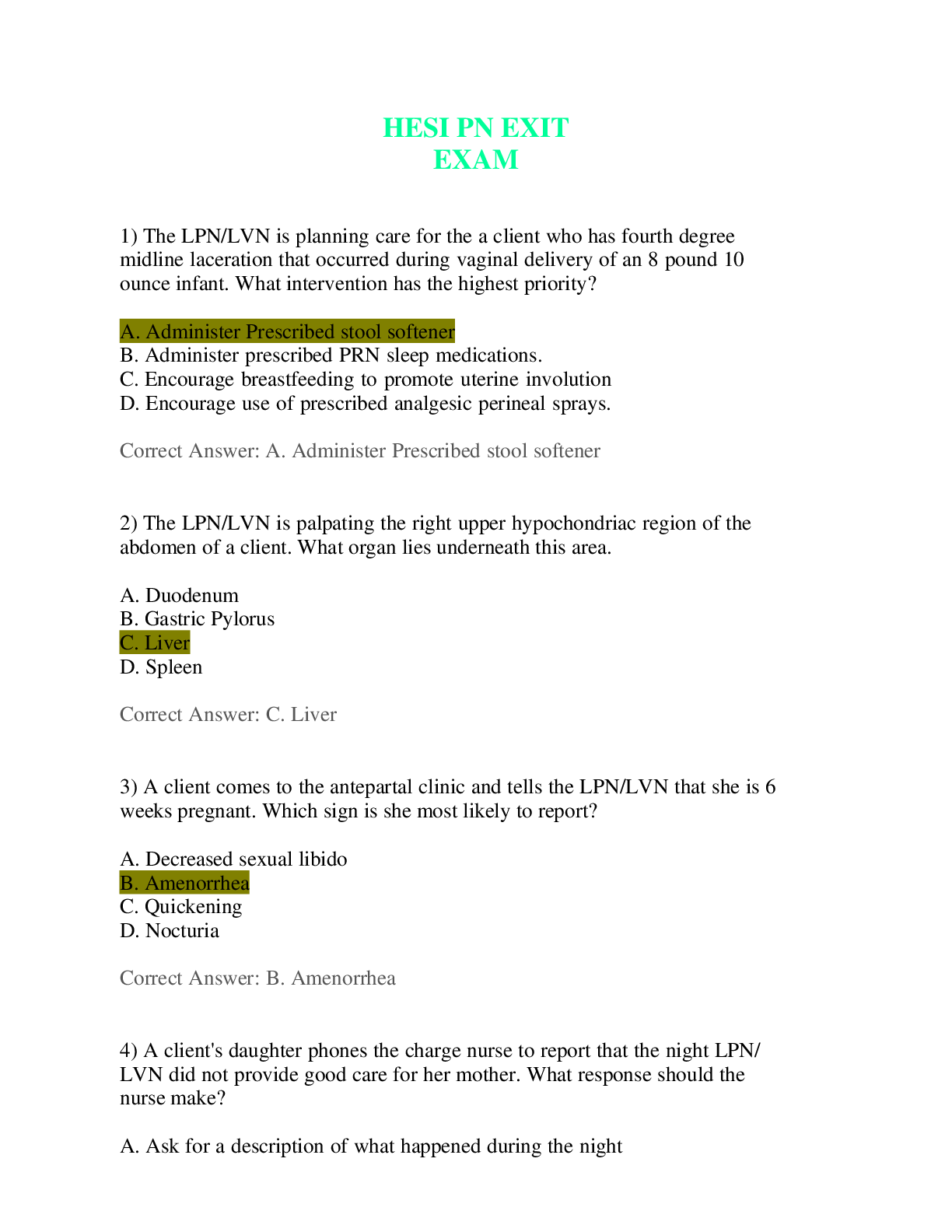
.png)
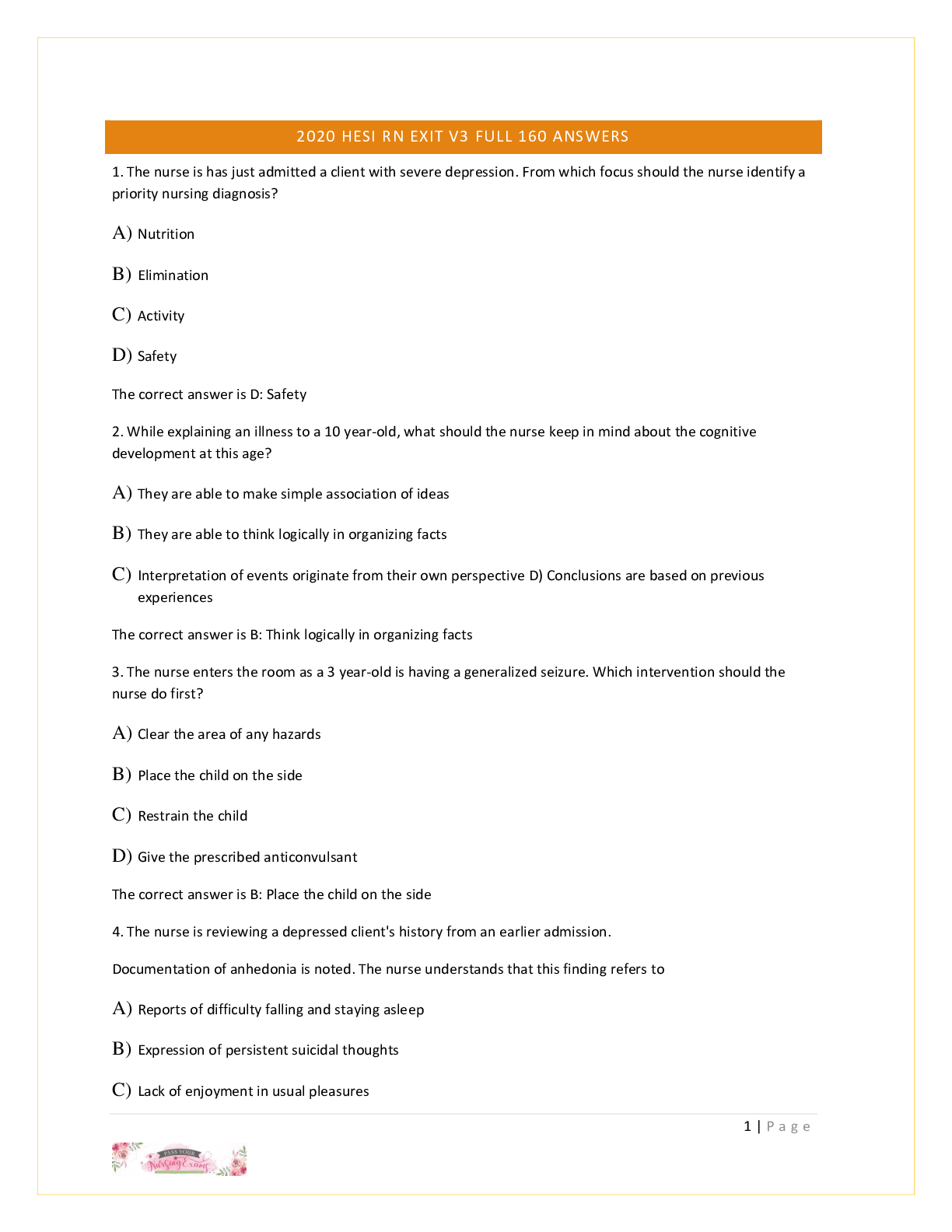

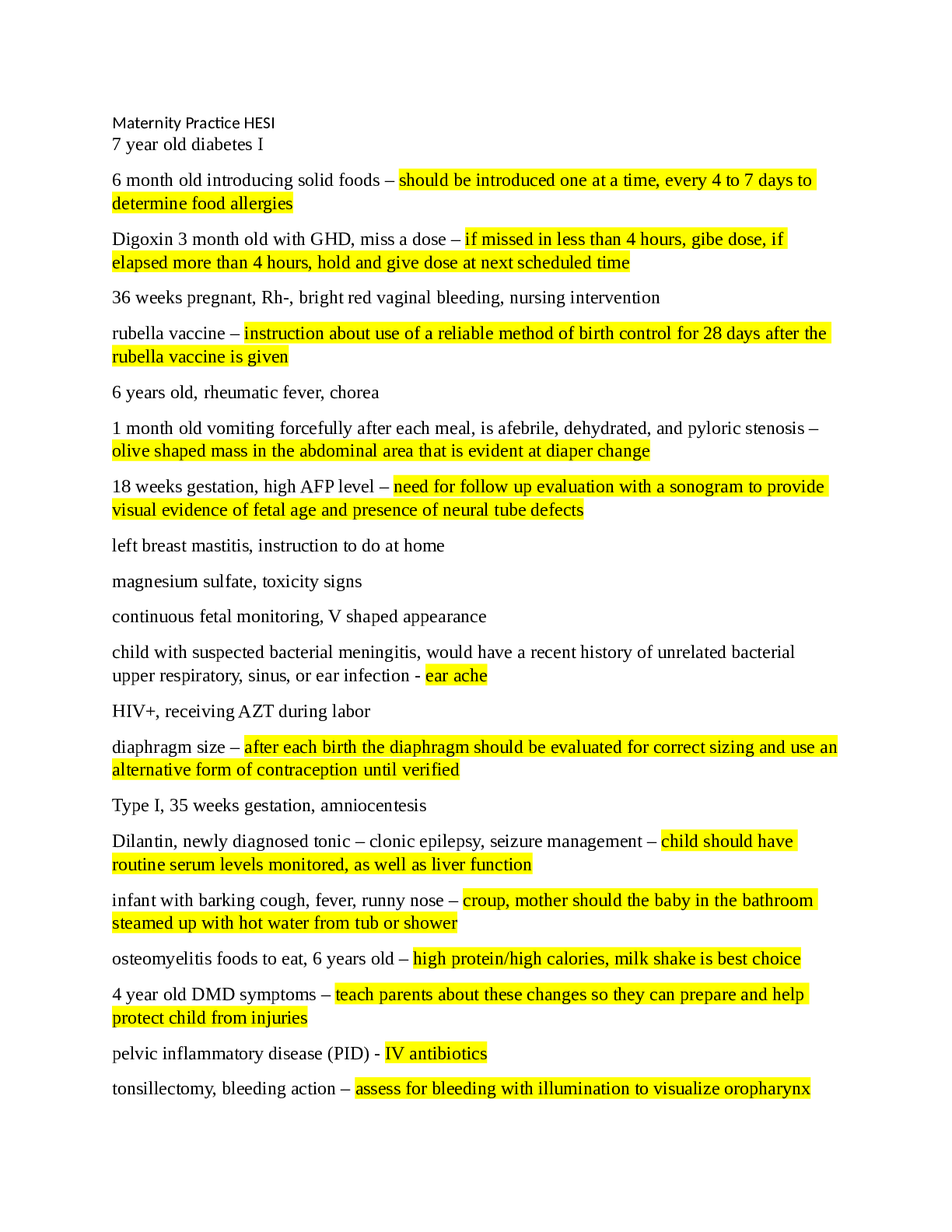
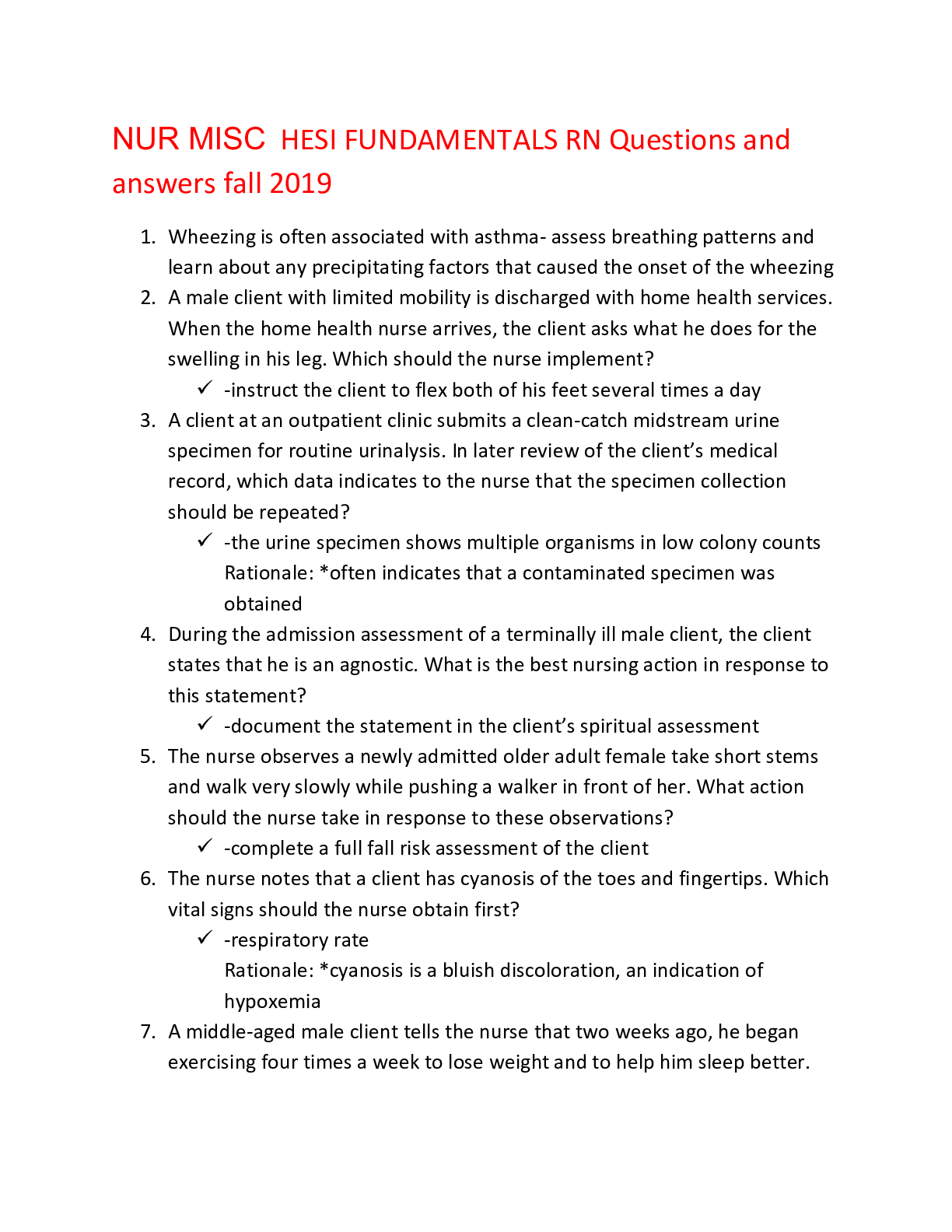
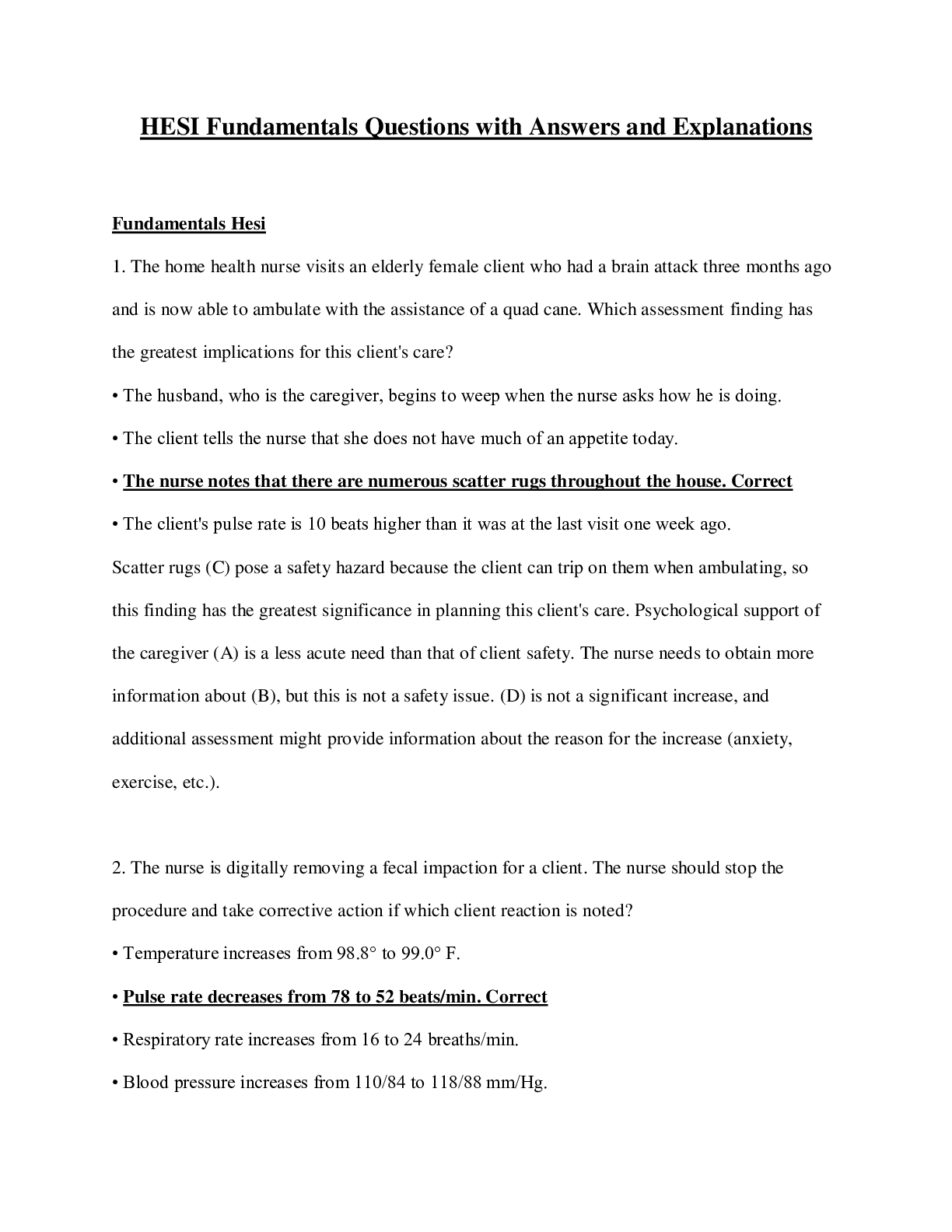

.png)
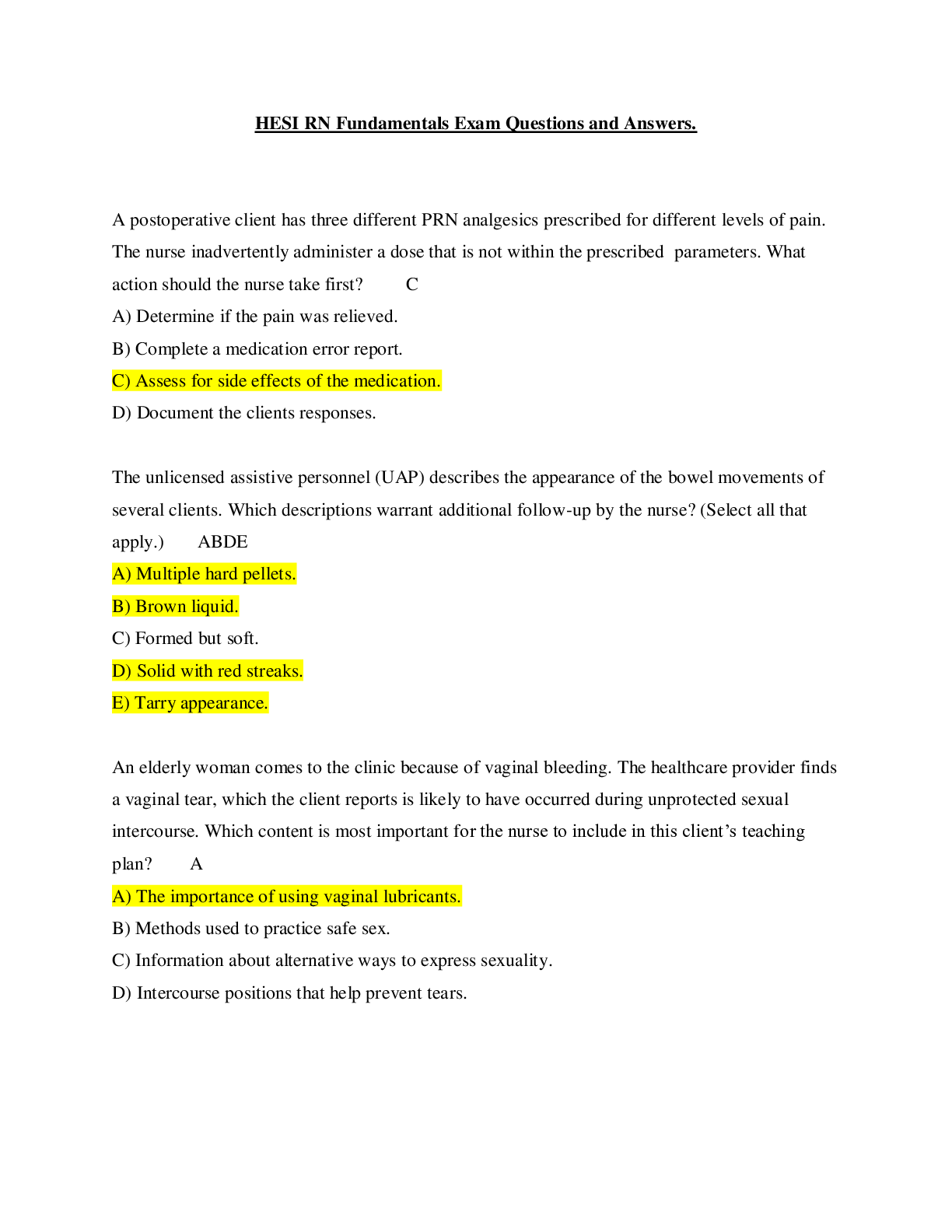
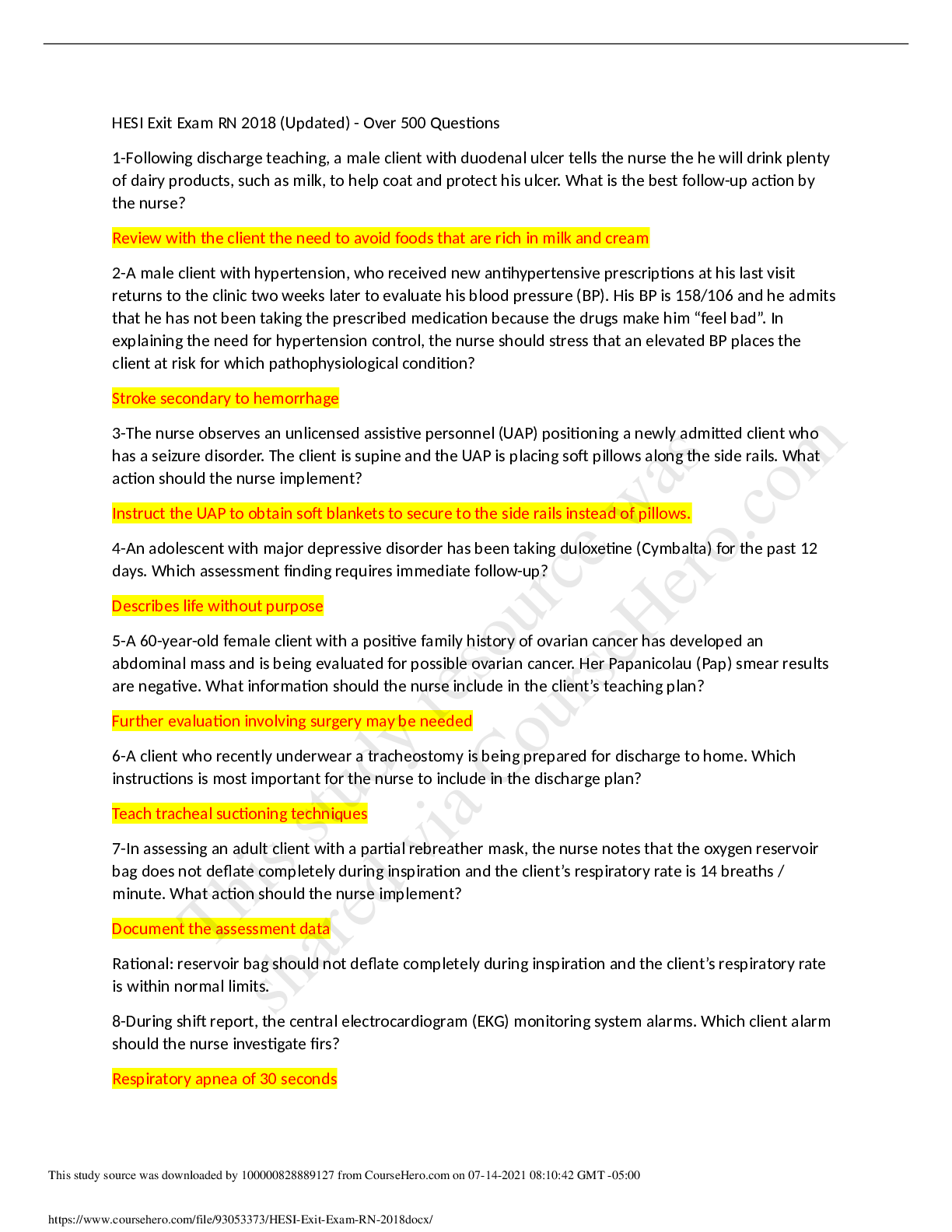


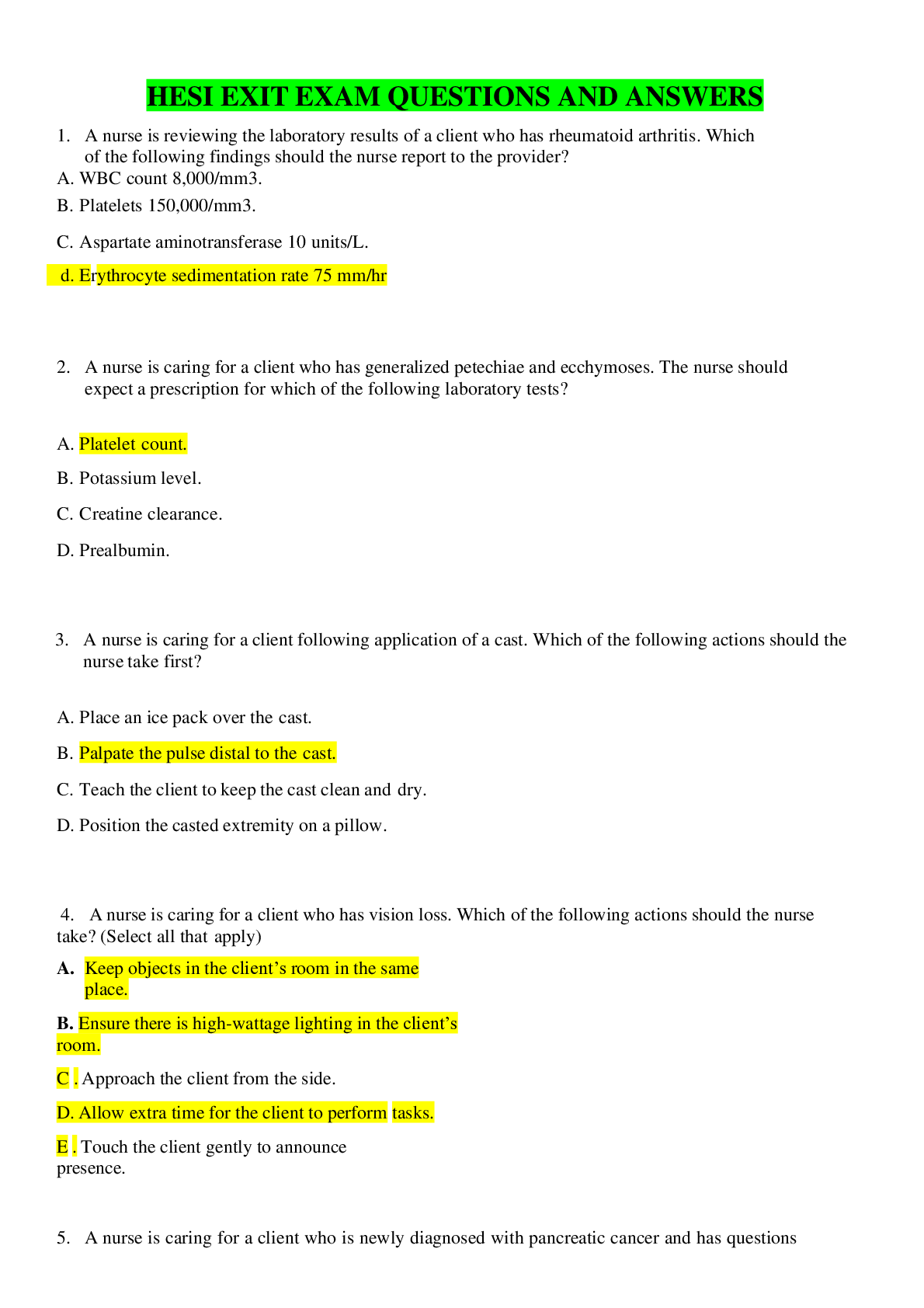






 (1).png)



